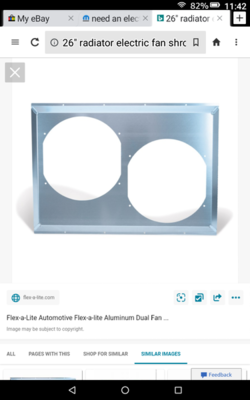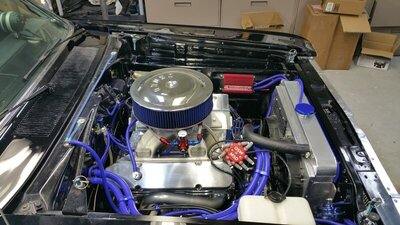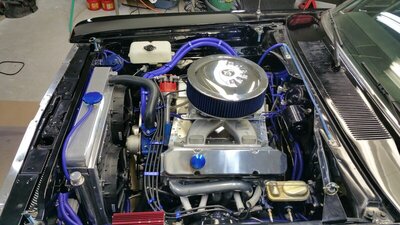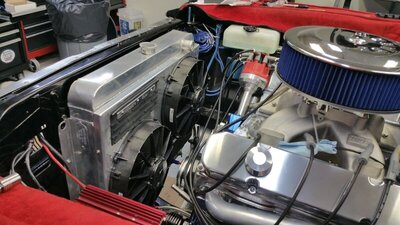IMO....
When it comes to fans, impeller diameter relates to CFM as well as impeller RPM. Relate this to a shovel: the larger the shovel, the more material is moved per shovelfull. The same aspect applies to fans....the bigger the impeller diameter the more air is moved per given RPM. There are additional factors involved: the number of impeller blades and their pitch angle. The rule of thumb that "bigger is better" definitely applies. To accurately compare more fans with a smaller impeller diameter vs one fan with a large diameter you must look at TOTAL area presented. Shrouding affects the EFFICIENCY of the fan ability to move air by reducing the tendency for recirculation.
Location of the fan, either on the front of the radiator or behind it, effects the performance as the air DENSITY is less on the hot or engine side of the radiator. Lower air density means MORE CFMs must be moved to acieve the same results, volume wise. But because the air is less dense, less HP is needed. Or...Refer to the following re gases..
The density of dry air is 1.29 grams per liter (0.07967 pounds per cubic foot) at 32 degrees Fahrenheit (0 degrees Celsius) at average sea-level barometric pressure (29.92 inches of mercury or 760 millimeters).
- At sea level and at 15 degrees C, the density of air is 1.225 kg/m3. This is the value of the ISA (International Standard Atmosphere). In other units, this is 1225.0 g/m3, 0.0023769 slug/(cu ft), or 0.0765 lb/(cu ft).1
- The IUPAC standard of temperature and pressure (0 degrees C and 100 kPa), uses a dry air density of 1.2754 kg/m3.2
- At 20 degrees C and 101.325 kPa, the density of dry air is 1.2041 kg/m3.
- At 70 degrees F and 14.696 psi, the density of dry air is 0.074887 lbm/ft3.
Affect of Altitude on Density
The density of air decreases as you gain altitude. For example, the air is less dense in Denver than in Miami. The density of air decreases as you increase temperature, providing the volume of the gas is allowed to change. As an example, air would be expected to be less dense on a hot summer day versus a cold winter day, providing other factors remain the same. Another example of this would be a hot air balloon rising into a cooler atmosphere.
And the effects of the "fan laws"
The Fan Laws are a group of useful equations for determining the effects of a change in the speed, the diameter of the fan and the density of air in the system. They are most useful for determining the impact of extrapolating from a known fan performance to a desired performance. So, in short, the basic fan laws are used to express the relationship between fan performance and power.
To start we will consider only the effect of a change in the speed of the fan on the flow rate, pressure and power consumption. We will assume that the fan size and air density are to remain constant.
The first three derivations of the Fan Laws are predicated on a couple of assumptions:
- That there is not an extreme difference in the change of rotational speed of the impeller in question and as such creating significant differences in the density of the air. However, it is unlikely that this would be a problem. You will not be looking at situations beyond the design speed of the impeller. Ignoring special applications, the upper limit for the RPM will be approximately 3600 (60hz supply frequency)
- That there is no change in the diameter of the fan
The First Fan laws: Volume of Air
The first law of fans is a useful tool when working out the volumetric flow rate supplied by a fan under speed control or conversely working out what the RPM would be to deliver a required volume of air and hence what frequency to set a variable speed drive (VSD) to.
Volumetric flow rate (V, m³/hr) varies directly proportional to the ratio of the rotational speed (RPM) of the impeller.
The Second Fan Law: Pressure
This second law describes the relationship between the pressure developed by the fan and its rotational speed. From this equation, we can see just how powerful the effect of increasing the rotational speed of the fan is on pressure development, double the speed and you quadruple the pressure development.
Pressure (P, Pa) varies as the square to the ratio of the rotational speed (RPM, u/min) of the impeller.
Eq. 2
Where:
p2: Pressure 2, Pa
p1: Pressure 1, Pa
U1: RPM 1, u/min
U2: RPM 2, u/min
Pressure Example
The Third Fan Law: Power
The third law provides the required power to deliver the performance change that the system designer is looking for. The cubic nature of this relationship between power and the rotational speed shows how even for small performance gains, large amounts of additional power are needed.
Power (P, kW) varies as the square to the ratio of the rotational speed (RPM, u/min) of the impeller.
Where:
P1: Power, kW2
P2: Power, kW1
U1: RPM 1, u/min
U2: RPM 2, u/min
There are many different factors involved in making the correct size of the fan either by scientific methodologies or the "guess and by golly" principle.....I prefer the scientific approach.....the choice is yours as to method you prefer. If you want/need additional info, just Google three fan laws.
BOB RENTON




















